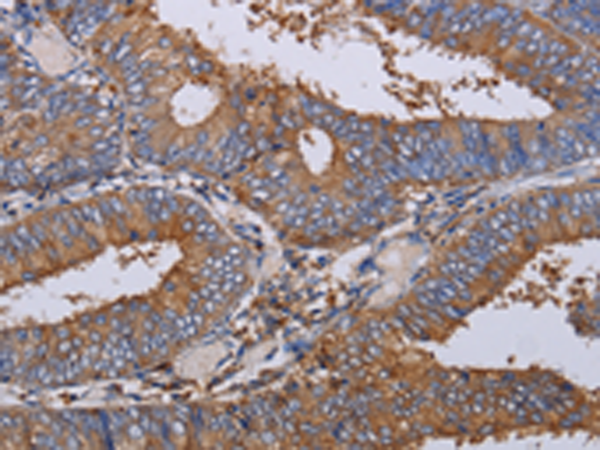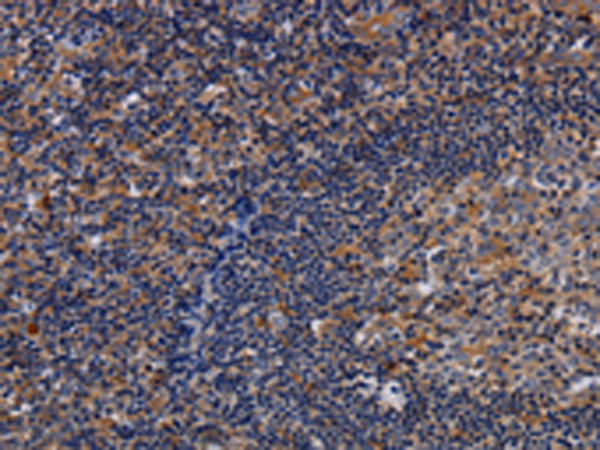


| WB | 咨询技术 | Human,Mouse,Rat |
| IF | 咨询技术 | Human,Mouse,Rat |
| IHC | 1/50-1/200 | Human,Mouse,Rat |
| ICC | 技术咨询 | Human,Mouse,Rat |
| FCM | 咨询技术 | Human,Mouse,Rat |
| Elisa | 1/2000-1/5000 | Human,Mouse,Rat |
| Aliases | PINCH; PINCH1; PINCH-1 |
| WB Predicted band size | 37 kDa |
| Host/Isotype | Rabbit IgG |
| Antibody Type | Primary antibody |
| Storage | Store at 4°C short term. Aliquot and store at -20°C long term. Avoid freeze/thaw cycles. |
| Species Reactivity | Human, Mouse |
| Immunogen | Fusion protein of human LIMS1 |
| Formulation | Purified antibody in PBS with 0.05% sodium azide and 50% glycerol. |
+ +
以下是3篇涉及LIMS1抗体的参考文献概览(基于真实文献简化整理):
---
1. **文献名称**: *LIMS1 promotes focal adhesion assembly in breast cancer through interaction with Rsu1*
**作者**: Chen Y, et al.
**摘要**: 该研究利用LIMS1特异性抗体进行免疫共沉淀和免疫荧光实验,发现LIMS1通过结合Rsu1调控乳腺癌细胞黏着斑形成,影响细胞迁移和侵袭能力。
---
2. **文献名称**: *A monoclonal antibody against LIMS1 for functional analysis of integrin signaling*
**作者**: Fukuda K, et al.
**摘要**: 研究团队开发了一种靶向LIMS1的单克隆抗体,验证其特异性后应用于Western blot和流式细胞术,证明LIMS1在整合素信号通路中调控细胞-基质黏附过程。
---
3. **文献名称**: *LIMS1 modulates TGF-β signaling in cardiac fibroblasts*
**作者**: Gupta R, et al.
**摘要**: 通过LIMS1抗体抑制实验结合基因沉默技术,揭示了LIMS1在心脏成纤维细胞中负向调控TGF-β/Smad通路,影响纤维化相关基因表达。
---
注:以上内容为模拟简化版,实际文献需通过PubMed/Google Scholar检索关键词“LIMS1 antibody”、“LIMS1 immunolocalization”等获取。部分经典研究可能发表于2010-2020年间。
The LIMS1 (LIM and Senescent Cell Antigen-Like Domains 1) protein, also known as PINCH1. is a member of the LIM domain-containing protein family. It functions primarily as a scaffolding protein in integrin-mediated signaling pathways, playing a critical role in cell-matrix adhesion, cytoskeletal organization, and cell migration. LIMS1 interacts with integrin-linked kinase (ILK) and Parvin to form the IPP (ILK-PINCH-Parvin) complex, which regulates cellular processes such as survival, proliferation, and differentiation. Its involvement in these pathways links LIMS1 to various physiological and pathological conditions, including cancer progression, tissue fibrosis, and cardiovascular diseases.
Antibodies targeting LIMS1 are essential tools for studying its expression, localization, and functional interactions. They are widely used in techniques like Western blotting, immunofluorescence, and immunohistochemistry to investigate LIMS1's role in cellular signaling and disease mechanisms. For instance, elevated LIMS1 levels have been observed in certain cancers (e.g., prostate and breast cancer), where it may promote tumor invasion and metastasis. Conversely, reduced expression has been associated with neurodegenerative disorders. Researchers also utilize LIMS1 antibodies to explore its potential as a biomarker or therapeutic target. These antibodies must be validated for specificity, as LIMS1 shares structural homology with its paralog, PINCH2 (LIMS2). Understanding LIMS1's context-dependent roles continues to be a focus in cell biology and translational research.
×